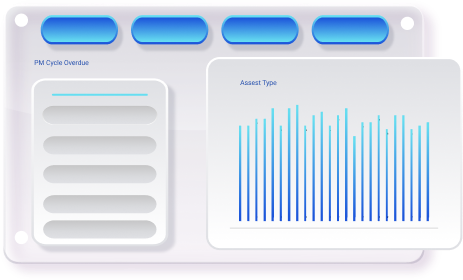Unlock the future of asset management with SEW’s SmartWX platform. By leveraging advanced GIS integration and AI/ML capabilities, SmartWX revolutionizes asset monitoring, management, and maintenance across the entire lifecycle. This intelligent platform offers a comprehensive 360 view of assets, enhances spatial awareness with GIS integration, and optimizes maintenance through predictive analytics. Seamlessly integrating IoT data, SmartWX provides real-time insights for proactive and efficient asset management. With robust reporting tools and mobile enablement for field technicians, SmartWX ensures precise and flexible asset management tailored to your needs.
Transform your asset management strategy with SEW SmartWX and achieve unprecedented reliability and performance!
Achieve Comprehensive Asset Oversight with Asset 360 View
The Asset 360 view in SEW's SmartWX platform centralizes asset health, performance, and maintenance history, enhancing governance and decision-making. It enables efficient asset management with filtering, inspections, and seamless oversight. Enhanced data visibility offers a comprehensive view of asset status and history, while automated monitoring and reporting ensure regulatory compliance.
AI/ML-Driven Predictive and Preventive Maintenance
The AI/ML-driven Predictive and Preventive Maintenance in SEW's SmartWX platform uses advanced AI/ML to forecast asset failures and manage assets intelligently, reducing downtime. It optimizes preventive maintenance by setting schedules based on asset types and needs. Automated workflows streamline preventive maintenance, extending asset lifecycles.
Enhance Field Operations with SmartWX Mobile enablement
With quick access to comprehensive asset information, efficient search functionality, and editable data, technicians can easily manage service requests and work orders. The immersive map view and organized asset hierarchy ensure operational efficiency and informed decision-making in the field.
The Power of AI Platform for EnterpriseAsset Management
Unlock the power of SmartWX's Asset Management Platform for enhanced maintenance efficiency, predictive insights, and cost optimization across all assets. Visualize real-time asset health, extend lifecycles, and streamline investment planning with user-friendly tools. Ensure uptime, avoid failures, and optimize resource allocation for unparalleled asset performance.
Asset 360 View for Comprehensive Oversight
Provides a complete view of asset health, performance, and maintenance history, enabling efficient governance and decision-making.
Enhanced Spatial Awareness with GIS Integration
Utilizes advanced visualization on Smart Maps pre-integrated with ESRI/ArcGIS, offering strategic insights for optimal asset management.
Remote Monitoring and Management
Seamlessly integrates IoT data for real-time monitoring and predictive analytics, enabling proactive maintenance and rapid issue resolution.
AI/ML-Driven Predictive and Preventive Maintenance
Employs AI/ML to forecast asset failures and automate maintenance schedules, minimizing downtime and extending asset lifecycles.
Comprehensive Reporting of Assets
Offers detailed reports on asset lifecycle, health, and work order management, supporting efficient resource allocation and informed decision-making.
Strategic Planning and Management
Leverages real-time data analytics for proactive service management, optimizing asset performance and operational efficiency.
Mobile Enablement for Field Service Technicians
Provides an intuitive mobile platform for effortless asset management, enabling technicians to access, inspect, and organize assets efficiently on the go.
Build the ConnectedEcosystem
- Maintenance Planning and Scheduling
Intelligently plan and prioritize maintenance activities based on asset criticality and resource availability. Automatically assign work orders to suitable field technicians.
- AI driven Work Order Creation
Intelligently plan and prioritize maintenance activities based on asset criticality and resource availability. SmartWX auto created work order for asset repair and maintenance and Automatically assign work orders to suitable field technicians.
- Mobile Workforce Enablement
Technicians receive work orders and asset information on mobile devices. Access digital manuals, training materials, and expert collaboration tools.
- On-Site Maintenance and Documentation
Technicians navigate to asset locations and execute maintenance activities. Document work, capture asset condition data, and update work order status in real-time.
- Data-Driven Decision Support
Generate comprehensive reports and dashboards on asset lifecycle, maintenance costs, and performance. Optimize asset deployment, maintenance strategies, and resource allocation.
Platform Benefits
- 50%Reduction in SLAs
- 48% - 52%Increase in Operational Efficiencies
- 80%Increase in First Time Fixes
- 100%Reduction in Paperwork and Manual Processes
Solutions for Your Industry
Electricity
Optimize grid reliability, extend asset lifecycles, and drive sustainable operations through real-time monitoring, predictive analytics, and AI-driven maintenance strategies.
Gas
Gain unprecedented pipeline integrity visibility, preempt failures, optimize maintenance schedules, and elevate resource efficiency through IoT-enabled remote monitoring and predictive analytics.
Water
Proactively safeguard aging water infrastructure, minimize downtime risks, ensure uninterrupted supply, and maximize operational excellence with predictive maintenance capabilities.
Telecom
Maximize network uptime, reduce costs, and deliver superior connectivity by strategically managing critical telecom assets through proactive maintenance planning and real-time insights.
Frequently Asked Questions
.accordion-body, though the transition does limit overflow..accordion-body, though the transition does limit overflow..accordion-body, though the transition does limit overflow..accordion-body, though the transition does limit overflow..accordion-body, though the transition does limit overflow..accordion-body, though the transition does limit overflow..accordion-body, though the transition does limit overflow..accordion-body, though the transition does limit overflow..accordion-body, though the transition does limit overflow..accordion-body, though the transition does limit overflow.


